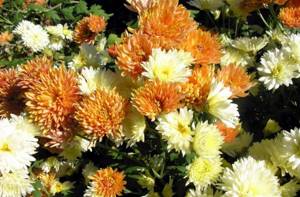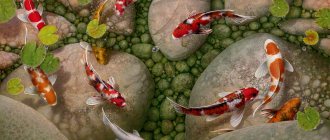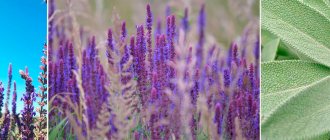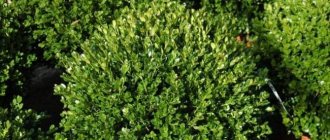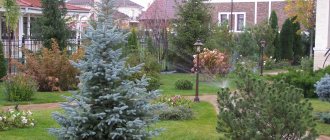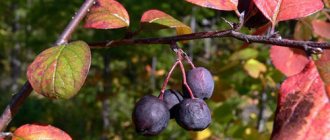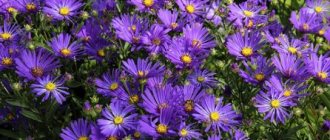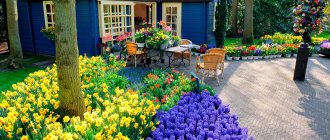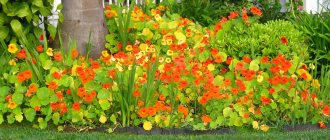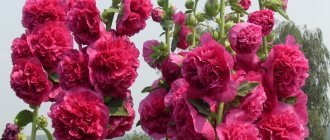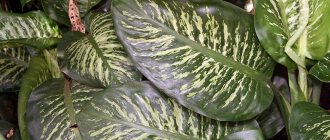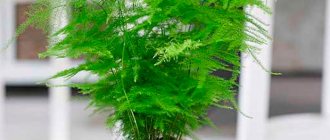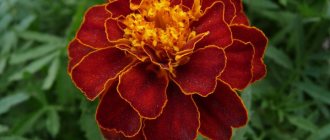Starting from mid-summer and throughout September, colorful multicolors can be observed in many areas. Carnival of autumn colors. At this time, our favorite flowers bloom vigorously - roses, dahlias, gladioli, as well as the queens of autumn, asters. Many of us associate these flowering plants with autumn, with school, with nature bursting with flames of foliage, and the first frosts. Among different peoples of the world, the aster symbolizes love, sadness, and grief. At the same time, the same aster is a symbol of sophistication and grace in European and Eastern countries.
It is these lush beauties, varied in shape and color, that we will talk about today.
First, a little history. “Star” is exactly how the name of the flower is translated from Greek. Indeed, the baskets of inflorescences resemble stars, small or large, depending on the variety.
One of the most beautiful legends believes that the aster grew from a speck of dust that fell from a star. Another is that these are the tears of the goddess Aphrodite, who looks from the sky, dropping them out of love.
There are a lot of legends about this beauty, each of them is charming in its own way. But the fact that asters have been known to mankind for many centuries is undeniable.
Asters on the site in combination with other plants and flowers
Predecessors and neighbors of asters
To prepare the soil before planting flowers in open ground, it is important to know which proximity to other plants is favorable and which is unfavorable.
It is important to know which predecessors and which neighbors best influence the health of asters.
It is better to plant asters in the place where perennial herbs such as alfalfa, clover, marigolds, and calendula grew before them. These plants nourish, neutralize, and prepare the soil well. It will be much easier to avoid diseases, since these herbs are the best predecessors of our “stars”. And if, in addition, you plant phlox and nasturtiums nearby, you can prevent damage by fusarium, one of the most common diseases.
Potatoes and tomatoes are not the best predecessors for asters. You can include tulips, gladioli, and carnations in the same company.
| Predecessors | Neighborhood |
| + Alfalfa, clover, marigolds, calendula | + Phlox, nasturtiums |
| — Tomato, potato | — Tulips, gladioli, carnations |
Selecting a location on the site and preparing the soil
It is better to change the planting site for asters every year. If the soil where the asters were planted was contaminated with a fungus, then it is better not to return them there for 5-6 years.
The best place on your site for asters will be moderately humid, sunny or slightly shaded. It is recommended to fertilize soil with high acidity with lime beforehand (in the fall) or feed it with wood ash in the spring before digging. Of course, it is better if the soil is neutral or slightly alkaline. To avoid fusarium disease, do not use manure for feeding! In autumn, when preparing the soil, it is better to use compost or humus.
Methods for growing asters in open ground
There are two ways to plant annual asters in open ground - seedlings and non-seedlings.
Seedling method
Once you have decided that these unpretentious plants should definitely decorate your garden, you can purchase seeds of the varieties you like and start planting.
For annual flowers, there are two main methods of planting - seedlings and non-seedlings . This is done by sowing seeds.
Already in March, you can start growing seedlings if you chose the first, more reliable, method.
First of all, choose a container that will be convenient to cover to create a greenhouse effect. It would be a good idea to add drainage to the bottom of the container so that excess water does not linger.
The soil can be taken from the garden, enriched with peat and sand, and also disinfected with a weak solution of potassium permanganate: 1 g per 5 liters of water. There is no need to worry too much about the fact that the soil on your site may be infected with fungus or parasites. It is important to properly treat and fertilize the planting soil.
The agricultural technology for growing aster is simple - plant seeds must be placed shallowly in the soil, literally 0.5 - 1 cm, and cover the container with film to create a greenhouse effect. As soon as the seeds sprout, you can remove the film.
Aster seedlings ready for transplanting
Remember that “Stars” do not like soil that is oversaturated with moisture. Therefore, you can water the seedlings abundantly, but rarely.
When the seedlings reach a height of 10–13 cm, you can safely plant them in open ground.
On a note! The most favorable soil for asters is loam, which does not retain excess moisture and does not dry out quickly.
Seedless method
The second, seedless method of planting seeds in open ground is less troublesome. Often, when planting, two methods of such sowing are used - in early spring or in autumn.
When planting in spring, it is enough to plant the seeds in pre-moistened soil to a depth of no more than 2 cm, sprinkle with soil, water with warm water and cover with film. Before the sprouts emerge, it is better not to water again. When the sprouts sprout, it is better to thin out the seedlings. But don’t throw away the extra sprouts, plant them in another bed, they can also please you in the fall.
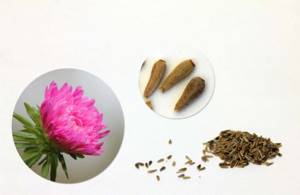
Aster seedlings ready for transplanting
Autumn planting is used much less frequently. In this case, the seeds are planted when the ground is already slightly frozen, so it is almost impossible to deepen the seeds into the ground. In this case, the seeds are sprinkled on top with compost or humus to a height of 3-4 cm. In the spring, when the soil has thawed, you can carefully loosen the rows and leave the top layer of compost for successful seed germination.
As for perennial varieties of asters, this type of plant is mainly propagated by dividing the bushes. If you nevertheless decide to grow seedlings yourself from seeds of perennial varieties, we recommend doing this from April to July, and it is better to plant seedlings in the soil in September. In all other respects, we adhere to the same rules as with one-year-old relatives.
Even if you are an inexperienced, novice gardener, asters will delight you with their unpretentiousness. If the simple sowing rules are followed, then a new stage will begin in the spring, awaiting the fireworks of colors from the Queen of Autumn. The main thing is not to stop and take the same care of annual or perennial plants; these flowers do not require much time and effort.
Caring for asters: growing and care
You should start by choosing the most suitable place for planting a flower. A well-lit area in this case will be the best choice. It is better if flowers have not grown in this place for the previous 5 years, since the remains of old plants can cause infection.

It is also important to ensure good drainage. Astra does not tolerate excess and stagnation of water. You need to make sure that the groundwater in the place chosen for planting is deep enough.
The soil under the aster should be neutral or slightly alkaline. You need to add sand or loam to the composition, then the bushes will feel comfortable. Soil preparation should begin in the fall.

Up to 4 kg of humus or compost should be added to the soil dug to a depth of 30 cm. You can also add potassium salt and superphosphate in doses recommended for given conditions. It is not recommended to use fresh manure.

It is better to use seedlings for planting in the ground. To do this, at the end of March, the seeds are sown in pots. In a greenhouse this can be done in April. The first shoots will appear in 5 days.

The stronger and more hardened the seedlings have grown, the greater the chance that they will take root in open ground. Suitable planting material is 6-10 cm in height and has 5 large green leaves.

Loosening the soil is an important process in caring for asters. This should be done after each irrigation. In order not to damage the root, you need to loosen it to a depth of no more than 6 cm. Hill up the bush to a height of up to 7 cm. This helps strengthen the rhizome.

Insufficient watering will lead to shredding of the inflorescences. This can be avoided by watering the bushes rarely, but abundantly. Thanks to this simple care, you can grow stunningly beautiful plants on your site that will decorate your flower beds with bright colors.
Timing for sowing asters for seedlings, planting seedlings and seeds in the ground
| Annual varieties | |
| Sowing seeds for seedlings | March–April (favorable dates can be checked in the gardener’s calendar) |
| Planting seedlings in open ground | end of May or when frosts have completely stopped |
| Planting seeds in open ground | November, in frozen ground or May |
| Perennial varieties | |
| Sowing seeds for seedlings | April June |
| Planting seedlings in open ground | September |
Important to remember!
- asters do not like overly moist and acidic soil;
- to enrich the soil with oxygen and prevent acidification, it is necessary to periodically loosen the soil;
- any plants, whether herbaceous, annual, or perennial, need disease prevention, and therefore it is necessary to weed and remove weeds from the soil
Rules for planting in open ground
Before planting seedlings or sowing seeds in open ground, do a few simple things:
- disinfect the soil. This can be done with a solution of potassium permanganate (1 g per 5 liters of water)
- loosen the soil well
- you can add peat and sand to the soil before loosening
- After planting, be sure to water thoroughly and do not moisten for 2 weeks after that. Water only when absolutely necessary (severe drought)
Proper planting of asters in open ground
Transplantation and propagation
Most often, propagation is practiced by seeds, which are planted in early spring in order to obtain strong seedlings. For this purpose, high-quality, properly prepared seeds are used, which are planted in slightly acidic soil. If the seedlings have managed to gain strength in a couple of months, then they can be transferred to open ground at the end of spring. There is another way, when the seeds are planted directly in open ground. But remember that in this case, you should expect flowering in the same season only by mid-autumn.
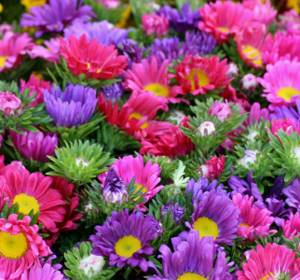
If we talk about perennial species, they are most often sown in the ground before winter. These plants will bloom only after a year or two. At this point, asters can be propagated vegetatively by dividing the bush. It is best to do this in early spring and use only strong bushes for propagation. Please note that the divisions must have at least three strong shoots and a sufficient number of roots for good rooting.
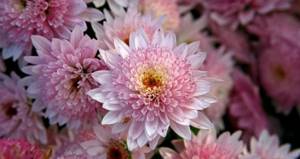
It is also known in the dacha business to propagate asters by apical cuttings. To do this, it is necessary to cut strong, viable cuttings measuring 7-8 cm, and root them in a nutritious soil mixture - sand, peat, turf. After this, the cuttings should be kept in a small greenhouse, or simply under a film, for 30-40 days, and planted in open ground at the end of summer or at the very beginning of autumn.
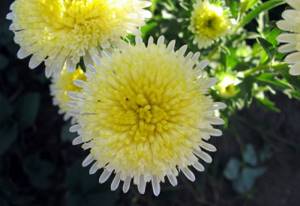
Caring for asters
In order for planted seeds or seedlings to grow into luxurious terry bushes, they need to be looked after.
Watering
Abundantly, but not often. Make sure the soil is not very wet. This will lead to rotting and acidification of the soil, which will cause disease.
Hilling
Once every two weeks, or as weeds and grass grow, weed the beds and loosen the soil between the stems. This is necessary for good oxygen penetration to the plant roots.
Top dressing
Asters, like most other plants, will be happy to be fertilized with mineral fertilizers. Already 2 weeks after planting seedlings in the ground, you can fertilize with potassium sulfate, superphosphate or wood ash. It is also necessary to feed the flowers with fertilizer during the set of buds and flowering.
Thinning
Thinning of flowering plants occurs naturally. Cut stems should be immediately pulled out and destroyed. Flower stems affected by disease or insects should also be destroyed immediately. In this way thinning will occur. It is important that each stem has enough space for full development.
Transfer
If you decide to thin out your flowerbed, then under no circumstances throw away the extra bushes. Pull out the stem with the root and surrounding soil and plant it in another place. It will quickly recover and bloom. These flowers are so unpretentious that they can easily tolerate transplantation.
Garter and trimming
Varieties that grow up to 1.5 meters in height need to be tied for support. Otherwise, the bush may fall apart and the stems may break. This is more often required by perennial varieties such as New England.
Description of American asters
The identification of a number of species among asters into a separate mixed group of summer-autumn flowering is not accidental. There was a lot of confusion caused by the exact distribution of asters either to summer species or to autumn stars. After all, many summer asters bloom so late or bloom for so long that they also capture the beginning of autumn, actually mixing the two groups with each other.
And the identification of two subgroups within the framework of summer-autumn asters is easily explained and undeniable: the favorite and popular Euro-Asian species and the much rarer North American ones differ significantly from each other not only in flowering.
Changes in the classification of asters affected the group of North American species the most. Almost all American plants, as part of a large community of plant species in the family Asteraceae, were transferred from the genus Aster to the genus Symphyotrichum. The change in the official botanical name has little effect on the practical nuances of using and growing these types of asters, but is fully consistent with their status as special plants.
American asters, North American asters, or Symphiotrichums are beautifully flowering varieties of herbaceous perennials and subshrubs. Symphiotrichum got its name from the Greek concepts of “merge” and “hair”. It is no coincidence that these asters are called American: in nature they are found only on the American continents (with rare exceptions), and their distribution area is almost always limited to North America.
Symphiotrichums are herbaceous perennials with strong, straight, branching shoots that form wide and very stable bushes. The average plant height ranges from 70 cm to more than 1 m. As a rule, North American asters have alternately arranged, lanceolate, richly colored leaves.
Most American asters are small-flowered, with basket diameters from 1 to 3 cm, although the best varietal asters delight with much more striking inflorescences. But dozens of their baskets are collected in corymbs and clusters of complex inflorescences. The palette of colors with delicate, pure shades of lilac-lilac-white tones is inimitable.
The flowering period of American asters begins in June and ends only with the arrival of winter. Many of the most valuable species bloom only from September.
New England Symphyotrichum, or New England Aster (American aster, Symphyotrichum novae-angliae). © mahler9
Symphyotrichum virginiana, or Aster virginiana (Aster novi-belgii (Symphyotrichum novi-belgii). © Renato Aldo Ferri
Symphyotrichum dumosum.© HEN-Magonza
Diseases and pests
We have already mentioned the most common disease of asters - fusarium. Unfortunately, it is not the only thing they need to be protected from. What is it, how to avoid it and also how to prevent other diseases and pests from overtaking our “Stars”?
Diseases
- Fusarium is a disease that cannot be cured.
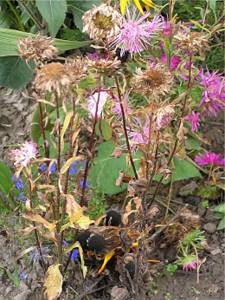
Aster disease Fusarium
It is better to undertake preventive disinfection of the soil before planting the plant. This is a fungal disease that infects the soil due to high humidity and acidity. Prevention, to exclude fusarium, will be adding lime to the soil before planting flowers. Remember about unfavorable predecessors (tomato, potato, gladioli, etc.).
- Septoria, or brown spot . Similar causes of occurrence are high humidity, high temperature. If you notice brown, rusty spots on the leaves, you need to destroy the affected plants and treat the flowerbed with copper oxychloride.
- Black leg . It is also a fungal disease that has the same causes as fusarium - acidification and excessive soil moisture.

Blackleg As you may have noticed, all diseases have similar symptoms and causes.
Remember ! For asters, soil that is not oversaturated with moisture and has low acidity is important.
Insect pests
It is important not to forget about insects, which severely damage the stems and inflorescences of plants. Among them are aphids , spider mites , and slobbering pennies . All these insects damage both the inflorescences and foliage of the herbaceous plant.
Most often, treating the flower garden with copper oxychloride or Bordeaux mixture helps combat these diseases.
Pests that transmit and cause diseases of aster. Aphid
For prevention, you can use an infusion of celandine: infuse a kilogram of herb in a bucket of hot water for 2-3 days. When watering, add a glass of infusion to a bucket of water.
Aphids can be fought with traditional methods, such as a solution of laundry soap with water or insecticides, which gives a more effective result.
Spider mites are afraid of karbofos. If you notice an insect on the flowers, which is not at all difficult, spray them with karbofos at a concentration of 0.2%.
The slobbering pennitsa is also hard not to notice. She leaves her larvae in foamy secretions on the axils of the inflorescences. Karbofos 0.2% is also used here.
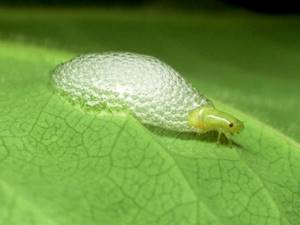
Slobbery pennies. Aster pest
Affected plants must be destroyed immediately. You shouldn’t worry too much that voids will form in places where diseased flowers grew. Asters tolerate transplantation well. Therefore, in such cases, you can simply dig up a healthy flower with soil that envelops the roots and replant it where there is space. It will quickly recover, and your flowerbed will remain blooming and evenly filled.
In any case, if you follow simple rules for the prevention and care of flowers, your flower beds will give you healthy and bright flowers.
Prevention and treatment against diseases and pests
To keep your plants healthy and insects to avoid them, it is important to follow simple rules:
- The soil should not be waterlogged
- Tools for working with plants must be disinfected with a strong solution of potassium permanganate.
- The soil can also be disinfected with a solution of potassium permanganate before planting seedlings or sowing seeds
- If an affected plant is noticed in the garden, it must be destroyed.
- Don't forget to loosen the soil between the flower stems
- The fight against insects that carry diseases must begin as soon as they are discovered
- Seeds used for seedlings must be of high quality and tested
North American species of summer-autumn asters
Symphiotrichums are quite diverse plants, although often the differences in their appearance come down to the color of the inflorescences and the structure of the bushes. The genus Symphiotrichum includes more than 100 species of plants. Despite the fact that almost all representatives bloom beautifully and can also be used as a garden crop, only less than ten species of American asters have become popular and are actively used by breeders to develop new interesting varieties.
Two species of American asters have become true legends in landscape design. They were introduced into culture after the Italian and Alpine asters, paying tribute to their amazing endurance for more than four centuries. The absolute favorites among American asters rightly include:
- Symphyotrichum novae-angliae, or New England aster (also known as American aster, Symphyotrichum novae-angliae) is a legendary, almost historical species of asters and one of the most popular plants. With a height of up to 2 m, it captivates with the scope of its dense, spreading, often sloppy bushes of branching, straight, densely pubescent shoots.
Lanceolate leaves do not create an impressively dense crown, but perfectly emphasize the beauty of flowering. With a diameter of up to 4 cm, the baskets of inflorescences of the New England aster surprise with the richness of the tone of pink-lilac-lilac reed flowers, yellow or reddish-brown tubular in the center.
This aster is always one of the last to bloom. In September and October, producing up to 30 inflorescences on a bush, it holds firm in any weather and pleases literally until the arrival of winter, withstanding even mild morning frosts.
New England asters are bushier, relatively compact plants with improved foliage and typically larger inflorescences. It is better to choose based on the color of the inflorescences and the shape of the bush. The best varieties for the middle zone are Gerberose, Lille Fardell, Septemberrubin, Bars Pink, Gloire de Kronstadt, Constance, etc.
- Symphyotrichum virginiana, or Aster virginiana (also known as Novo-Belgii aster (Symphyotrichum novi-belgii, Michaelmas Daisy) is a changeable, very plastic species that is easily recognized by the shape of the crown - back cone-shaped, expanding upward. Depending on the variety, the height of the bushes varies from 0.5 to 1.5 m. The shoots are straight and begin to branch densely in the upper part, which gives the bushes a bouquet-like shape.
Dense foliage makes this aster very elegant. The typical linear, narrow leaves are usually dark in color. One bush can bloom up to several dozen complex panicles or clusters of inflorescences, each of which consists of more than a hundred baskets.
The basket inflorescences of New Belgian symphyotrichums are limited to 2 cm in diameter, numerous reed flowers are painted in different shades of purple, completely hiding the tubular flowers in the center. These are profusely colored and very showy double asters that begin blooming in September.
Symphiotrichum virginiana is characterized by the most extensive selection of varieties. Various shades of color, height, and degree of terry make it possible to select more flashy or, conversely, modest plants. The most popular varieties for the middle zone include the meter-high varieties Saturn, Amethyst, Octoberfest, Royal Blue, Sunset and Ballard.
Symphyotrichum ericoides. © Dan Mullen
Symphyotrichum cordifolium. © Martha B. Moss
Symphyotrichum divaricatum. ©John and Kendra Abbott
The best representatives of the genus Symphiotrichum also include:
- Symphyotrichum dumosum is a fairly compact species that forms cushion-like bushes about half a meter high. In the West, this species of symphyotrichum is also known as dwarf novi-belgii asters, Mini Michaelmas daisies.
Straight shoots are densely branched and pubescent, and sessile leaves are entire and dark. The diameter of the inflorescence baskets of this aster is also limited to only 3 cm, but the flowering seems more spectacular due to the fact that the individual inflorescences are collected in sparse shields. The light lilac color of the small and narrow reed flowers contrasts pleasantly with the dark, dense greenery. This is a profusely flowering species of aster, which in August and September is literally covered with a scattering of baskets.
Numerous varieties of bush aster offer a choice of more compact, from 25 cm high, bushes with different variations of blue, lilac, lilac and pink colors (for example, medium-growing pink-colored Diana, dwarf fuchsia variety Venus, lilac dwarf Dwarf Nancy, snow-white variety about 30 cm high Niobea, etc.) Varietal plants are considered more resistant.
Heather symphyotrichum, or heather aster (Symphyotrichum ericoides) is a herbaceous perennial up to 1 m high with straight shoots, fancifully branching on thin long bushes, due to which the plant resembles heathers.
The leaves are small, linear, arranged alternately and stand out for their rather bright color. Despite the fact that the diameter of the inflorescences is limited to a maximum of 1 cm, they do not seem inconspicuous. A huge number of snow-white baskets cover the plant, reminiscent of a fairytale scattering or lace. This is one of the late-blooming asters, starting its show only in September.
Symphyotrichum cordifolium, also known as the blue forest aster, is a surprisingly delicate and changeable plant. The height can either be limited to 60-70 cm or stretch to more than 1 m. None of the other asters have stems that branch so densely. The reddish color of the shoots emphasizes the beauty of the dark, oval leaves with an unusual rough texture, with a heart-shaped base.
Sparse, spreading, multi-tiered panicles of inflorescences consist of small baskets, up to 2 cm in diameter, with strongly pointed reed flowers. The contrast of light pink, lilac or white with a yellow center seems surprisingly vibrant. This is a late blooming aster that attracts attention in September and October.
- Symphyotrichum splayed, or Aster splayed (synonym - Symphyotrichum corymbose, Symphyotrichum divaricatum) is a compact but very impressive species of symphyotrichum. This plant captivates with its lacy textures. With a height of up to 75 cm, the bushes are very spreading, dense, and small oval leaves on long petioles give the plant the effect of green lace.
Baskets of inflorescences with a diameter of about 3 cm surprise with the contrast of white reed and brown tubular flowers. The inflorescences are collected in loose shields, rising above the greenery. This is a late-blooming species of aster, blooming only in September and pleasing until frost.
- Symphyotrichum puniceum is a tall, lush species of asters with branched straight shoots and surprisingly dense foliage, creating a green lace effect. With a height of about 120 cm, this species of symphyotrichum boasts a unique purple-crimson hue of reed flowers around a lemon-shaped tubular center in inflorescences whose diameter exceeds 2.5 cm. This species blooms in mid-summer, and if the weather is favorable, it always re-blooms in the fall.
- Symphyotrichum laeve, or Aster naked (Symphyotrichum laeve) is a medium-sized, very strong species with a height of 70 to 120 cm, depending on the fertility of the soil. Strong, tough and straight shoots branch beautifully, flaunting regular lanceolate leaves with an almost imperceptibly jagged edge. Baskets of inflorescences up to 3 cm in diameter surprise with the soft lilac tone and the bright pink-purple color of the tubular flowers in the center. This is a species that blooms exactly in mid-summer and brings joy throughout July.
Symphyotrichum puniceum. © InAweofGod'sCreation
Symphyotrichum laeve, or naked aster (Symphyotrichum laeve). © appaIoosa
Proper seed collection
A good way to collect as many quality seeds as possible for later planting is to collect them yourself. This should be done in dry weather, after the flowers have withered. The disc of flowers should be brown or brown in color. It is enough to cut off the inflorescence basket and put it in a paper bag, putting it in a dry place to avoid rotting. This guarantees that next year you will again see your favorite varieties in your flower beds.

Self-collection of aster seeds
You can buy seeds in a store, but we have already said that the quality and shelf life in this case require special care. The number of seeds in the bags is very small; if not all of them sprout, it’s hard not to be upset.
But with so many varieties that are now known, it’s difficult to resist adding new ones to your flowerbed. Another way to diversify your collection is to exchange interesting new items with other people, gardeners or breeders.
American asters in garden design
All types of symphyotrichum are considered one of the best asters for group plantings. In mixed compositions, especially in the natural style, they demonstrate unique skills to merge into harmonious, “solid” ensembles with any neighboring plants. These types of asters do not look too neat, but their lush colors, picturesqueness and brightness, as well as late flowering periods, fully compensate for this shortcoming.
American asters look great:
- in massifs and imitations of wild prairies;
- in landscape continuous plantings and natural flower beds or mixborders;
- when planting in narrow ribbon flower beds;
- large and medium-sized groups on the lawn or clearings of ground covers;
- as a masking tape and border crop;
- in bright textural accents, when introducing large and lush plants with an unusual bush shape (especially small-flowered species like Symphiotrichum heather);
- in the edge and creating undergrowth framing large plants.
The group talents of this plant do not mean at all that symphyotrichums will be lost in splendid isolation. They can be safely introduced as single accents and even placed as a solo plant on the lawn. As an autumn accent, they fit perfectly into any complex ensembles - both ceremonial and functional.
American asters are superbly resilient when cut. For autumn bouquets, high varieties of New England and New Belgian symphyotrichums are most often used.
Partners for the American aster are bright, seasonal and “reliable” plants; they go well with partner perennials, crops with vertical or racemose inflorescences, as well as perennials that fit well into landscape ensembles. Asters of North American origin can suppress poorly competitive plants, so partners for mixed compositions are carefully selected, mixing them only with perennials and shrubs that can stand up for themselves.
American asters are good both in group plantings with other plants and in solo batches. © Thomas Rainer
Reproduction
Perennial varieties of asters are propagated by division and cuttings, while annual varieties are propagated by seeds.
Root division
In the spring, when the greenery of the bush has grown by 3-5 cm, you can start dividing. To do this, you need to pull the roots of the perennial plant out of the ground and carefully separate 1-2 buds. Each part will become an independent bush next year.
Cuttings
All types of perennial asters easily tolerate cuttings. To do this, you can take the upper part of the stem and root it in a bed with loose soil (turf-peat-sand). Cover with film. It is better if this place is a little in the shade.
Seeds
As already mentioned, the seeds are collected after the buds have bloomed. It is better to remove the dried seeds in a dark, cool, dry place. And in the spring, use the seeds for seedlings or non-seedlings.
Which types of asters should you choose?
To date, about 500 species of perennial asters are known in simple, semi-double and double forms.
According to flowering time, species can be divided into 3 groups. Early ones bloom already in May-June, summer ones - in July-August. Autumn asters delight us from September to November.
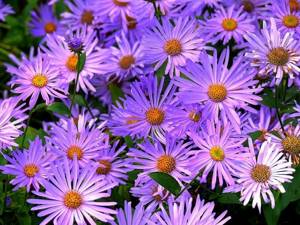
Among the early ones, the alpine aster stands out especially, which blooms before all the others at the end of May. This is a compact rosette plant no more than 30 cm high, forming lovely clumps. It grows well even on rocky soils. The main thing for him is a sunny place. The basal leaves remain green even in winter, and the small blue, white or lilac flowers look like modest daisies.
Of the summer species, the Italian aster (fricarti) deserves special attention. This is a lush perennial up to 60 cm high. Its leaves are linear-lanceolate, dark green. Baskets of lilac-blue flowers up to 4 cm in diameter are collected in corymbs. The aster blooms very profusely and for a long time - from late July to mid-October.
New England aster (American) forms magnificent bushes with decorative “rough” leaves up to 2 m high. Its inflorescences - carmine yellow or lilac pink - are collected in dense brushes of 25-30 pieces. It blooms in September.
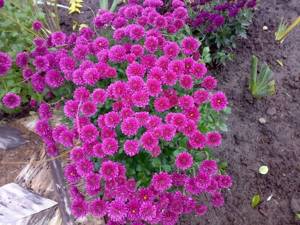
Aster New Belgian (Virginian) is also a tall shrub that looks like an inverted pyramid. The plant can reach a height of 1.5 m. The stems of the bush are woody, highly branched, bare or pubescent. Numerous purple, pink, dark red inflorescences-baskets are collected in panicles. Moreover, the flowers - sometimes up to 200 pieces - are placed in 5-6 rows! Because of its flowering in September, this variety was popularly called “September”.
Astra in landscape design
Undoubtedly, any flowers decorate flower beds or garden beds. The more magnificent the flowering, the richer and more luxurious any garden plot looks. The main thing is to tastefully select neighbors and place them in the same area.
Garden asters can be placed either in a strip along the fence or on an alpine hill, next to other garden flowers. It is in mixed flower beds that aster will look very beautiful in combination with perennial plants that bloom later or earlier. While the asters are gaining color and green foliage, earlier perennials may be blooming nearby.
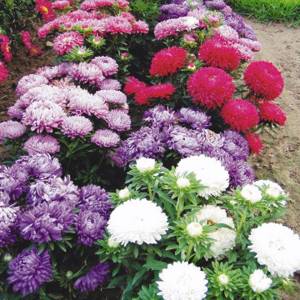
Asters are annual. In the flowerbed
The aster looks very advantageous against the background of decorative silver and gray grasses, as if complementing them with its deep color. They also go well with oriental poppy, stockrose or Echinops on an elevated alpine hill.
The queens of the autumn garden look stunningly beautiful in large baskets. Pay attention to perennial varieties of these herbaceous plants, such as Amethyst, Virginia aster, and New England aster.
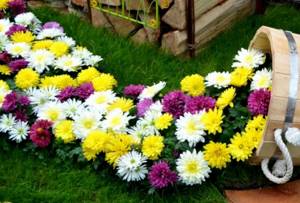
Various varieties of asters in a composition on the site
Asters are bright “Stars” that can decorate any garden and delight gardeners with their beauty for a long time. Not at all capricious, growing, by and large, in any climatic conditions, asters are quite worthy of being called the queens of the autumn carnival of flowers!
Secrets to successfully growing asters
Tags
asters pests predecessors seedlings neighbors care
Aster varieties
Aster belongs to the genus of herbaceous plants and belongs to the Asteraceae family. About 200 of its species are known to science. This plant is common in Eurasia and North America. In Russia you can find saltmarsh aster (Aster tripolium), naked (Aster laevis), willow (Aster salignus), multi-colored (Aster versicolor), lanceolate (Aster lanceolatus), white-bristled (Aster albosetus), Italian, chamomile, wild, European, steppe (Aster amellus). Asters bloom in September; they are winter-hardy and light-loving. This plant is a melliferous and medicinal plant.
